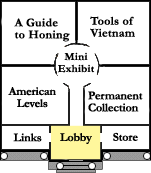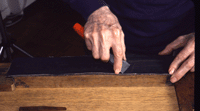

|
|
Table
of contents
|
|
A
Guide to Honing and Sharpening
Stropping
Click on the picture to enlarge
| The
purpose of stropping is not to abrade more metal, but rather to continue
bending, flexing, fatiguing, and burnishing off the miniscule metal
strands still clinging to the edge of the blade after the burr breaks
off. If you sharpen with waterstones and use a "gold" 8000
grit stone as a final step, stropping is not necessary. |
 |
Strop
the bevel and back of the tool using a smooth firm piece of leather
(very hard machine-belt leather is not good). Do not use abrasive
dressings on leather - they are coarser than the Arkansas stone
and will remove its effects. Wipe honing oil off the tool before
stropping. Strop on clean, undressed leather only.
A
good size for a strop is around 14" long by 3" wide. A single thickness
of leather, held down on the bench with the left hand as you strop
with the right, is satisfactory. However, it is worth the small
extra effort to tack two layers of leather onto a 1 ½" thick piece
of dressed wood, 12" x 3". A 1/16" layer of hard felt between
leather and wood makes an ideally mellow but firm strop that is
less prone to bend the micro-thin cutting edge at the end of a stroke.
The 1 ½" thickness of the wood allows it to be held in a vise, ¾"
proud of the surrounding surface, or to be comfortably elevated
above the bench, gripped by the left hand.
|
 |
A:
Strop in 1 direction only, with the tool's edge trailing. The little
animation on the left shows the stroke (hit your
browser refresh button to reanimate it again). holding the
bevel flat on the strop as if you were honing on a stone, draw the
chisel across the strop. It's comforting to know that when stropping
on leather the slight inaccuracy inherent in a one-handed stroke
doesn't do the bevel damage that it would do on stone - nevertheless,
try to keep your angle about as steady as if you were honing (on
stone). It's too easy to relax and to speed, and to curve your stroke
too much. Re-check the angle with a left hand finger from time to
time.
Notice
how the the follow-through of the stroke elevates slightly before
it goes off the end of the strop. The whole arm raises, like an
airplane taking off. Then replace the chisel at the beginning of
the strop and strop again. During the contact part of this stroke
the tool does not change angle. (The fragile, thin edge can actually
be turned if firmly pressed out of true on the upswing.)
|
 |
B:
After 10 or 20 strokes on the bevel, flip the tool over and strop
the back. Place the chisel blade flat on the strop and then draw itthe
length of the strop. Lift and repeat 10 or 20 times. |
| |
Repeat
steps A and B several times. The blade will change from sharp to silky
sharp. After this step you are ready to begin your woodworking. |


|
